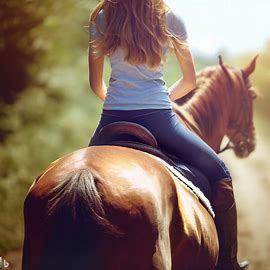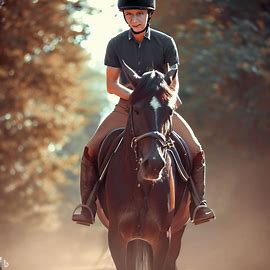Experience the thrill of horseback riding - a timeless adventure connecting you with nature and these majestic animals. Discover riding lessons, trails, and more.
Table of Contents1. Introduction
2. The History of Horseback Riding
3. Getting Started with Horseback Riding
4. The Different Types of Horseback Riding
· 4.1 Trail Riding
· 4.2 Western Riding
· 4.3 English Riding
· 4.4 Dressag
5. The Benefits of Horseback Riding
6. Preparing for Your First Ride
7. Essential Riding Gear
8. Mounting and Dismounting
9. Basic Riding Techniques
10. Safety Measures
11. Developing a Bond with Your Horse
12. Exploring Scenic Routes
13. Overcoming Challenges
14. Horseback Riding as a Sport
15. Conclusion
Introduction
Horseback riding is a thrilling and rewarding experience that allows individuals to connect with nature while enjoying the companionship of these magnificent creatures. Whether you're a seasoned rider or a beginner looking to embark on this exciting journey, this article will provide you with all the information you need to get started.
The History of Horseback Riding
The history of horseback riding dates back thousands of years. Horses have been domesticated and used for various purposes, including transportation, agriculture, and even warfare. Today, horseback riding is primarily enjoyed as a recreational activity, but it's essential to acknowledge its rich historical significance.
Getting Started with Horseback Riding
If you're new to horseback riding, the first step is to find a reputable riding school or stable in your area. Enroll in a beginner's class to learn the basics of horse care and riding techniques. Experienced instructors will guide you through the process and ensure your safety.
The Different Types of Horseback Riding1. Trail Riding
Trail riding is one of the most popular forms of horseback riding. It involves riding horses on designated trails, allowing riders to explore picturesque landscapes while enjoying the tranquility of nature.
2. Western Riding
Western riding is deeply rooted in cowboy traditions. Riders use Western saddles and focus on skills such as roping and cattle herding.
3. English Riding
English riding emphasizes precision and control. It is commonly associated with disciplines like show jumping, eventing, and dressage.
4. Dressage
Dressage is an elegant form of riding that emphasizes the harmony between horse and rider. It involves intricate movements and precise communication.
The Benefits of Horseback RidingHorseback riding offers numerous physical, mental, and emotional benefits. It promotes physical fitness, improves posture, and enhances balance and coordination. Moreover, the bond formed with your horse can have a profoundly positive impact on your emotional well-being.
Preparing for Your First Ride
Before you mount a horse for the first time, it's essential to understand the basics of horse care. Learn about grooming, feeding, and understanding a horse's behavior. This knowledge will help you build trust with your equine companion.
Essential Riding Gear
To ensure a safe and enjoyable riding experience, you'll need the following gear:
- Riding helmet
- Riding boots
- Gloves
- Riding pant
- Saddle and bridle
Mounting and Dismounting
Proper mounting and dismounting are crucial for your safety and the comfort of the horse. Your instructor will teach you the correct techniques, ensuring you start on the right foot.
Basic Riding Techniques
Learning how to sit in the saddle, hold the reins, and give commands to the horse are fundamental riding techniques. Mastering these skills is essential for a smooth and enjoyable ride.
Safety Measures
Safety should always be a top priority when horseback riding. Understand the potential risks, follow your instructor's guidance, and wear appropriate safety gear at all times.
Developing a Bond with Your Horse
Building a strong bond with your horse is a rewarding aspect of horseback riding. Spend time grooming, feeding, and interacting with your horse to establish trust and mutual respect.
Exploring Scenic Routes
One of the joys of horseback riding is the opportunity to explore scenic trails and beautiful landscapes. Research local riding trails and embark on memorable journeys.
Overcoming Challenges
As with any new skill, horseback riding may present challenges. Be patient with yourself and your horse as you both learn and grow together.
Horseback Riding as a Sport
For those seeking a competitive edge, horseback riding offers various equestrian sports and competitions. You can pursue show jumping, dressage, or even rodeo events.
Conclusion
In conclusion, horseback riding is a rewarding and exhilarating activity that allows you to connect with nature and develop a profound bond with these incredible animals. Whether you're a novice or an experienced rider, the world of horseback riding offers something for everyone.
FAQs1. Is horseback riding suitable for beginners?
Absolutely! Many riding schools offer beginner-friendly lessons with well-trained horses and experienced instructors.
2. What should I wear for my first riding lesson?
Wear comfortable pants, riding boots, and a riding helmet for safety. The stable may provide additional gear if needed
3. How long does it take to become a skilled rider?
Becoming a skilled rider varies from person to person. Consistent practice and dedication are key factors in improving your riding abilities.
4. Can anyone go trail riding, or do I need experience?
Trail riding is accessible to riders of all experience levels. Beginners can enjoy guided trail rides with expert supervision.
5. Are there age restrictions for horseback riding?
While horseback riding is suitable for people of various ages, some stables may have age restrictions for safety reasons. It's best to inquire with your chosen riding school.

.jpeg)






0 Comments